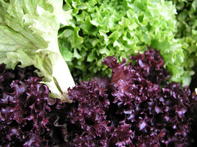Scientific name: Lactuta Sativa Common Name: Lettuce Lettuce is thought to have originated in parts of Asia, but the Egyptians are believed to be the first to start developing the plant for more palatable flavours from the wild and bitter taste of the first wild varieties.

Today lettuce is cultivated throughout the world in both open fields and in greenhouses.
Controlled atmosphere in greenhouse production has been very good for continuous supermarket supply and has benefited the lettuce supply and value chain to supermarkets that demand fresh and on time delivery of produce with extended shelf life abilities for their customers.
Large producers also still produce open field lettuce and have developed sophisticated supply chains to ensure quality and condition.
Plant Description
Lettuce has a short stem of about 10 cm from which a swirl of leaves grows into a tight ball of water-rich, crunchy leaves or the looser leaf varieties that set their leaves into a rosette of soft, tender leaves or an upright fan of tender, narrow interlocking leaves.
It is a sensitive plant and the leaves are easily damaged and because of their high water content, they wilt easily. The shallow root system is mainly concentrated in the top 20 to 30 cm of soil so the plants are also sensitive to water stress. The lettuce plant is mildly frost resistant.
Uses
Lettuce is mainly used in salads and in sandwiches.Soil Requirements and Preparation
Lettuce does best in sandy loam soils that drain well and have a high level of organic composition. The pH of the soil should be between 6 and 7. Take soil samples well before the planting date and have them analysed by a reputable laboratory.
One month before planting prepare the soil for optimum production by rectifying the soil nutrient content and pH balance through the addition of lime for too acidic soils and the addition of organic material like composts or manures.
Incorporate these into the top 300 mm to 400 mm of soil. When making the final preparation of the soil one week before planting, incorporate the pre-harvest fertilizer and the required trace elements into the top 20 cm to 30 cm of soil using a rotavator or disc harrow to mix in these nutrients as this also serves to remove the clods in the soil.
This process also serves the function of final mechanical weed control. Ensure that the plant rows and seedbeds are level and the soil is fine and clean.
This ensures that the very small lettuce seeds can be evenly planted to ensure uniform emergence, growth and development. It also provides a good bed if planting seedlings.
Many growers install the drip irrigation pipes onto or into these seed beds and cover these raised planting rows with plastic mulching to stop weeds and to reduce evaporation. The seedlings are then planted through the plastic mulching.
Climate
All lettuce varieties require cool weather and do best when temperatures during the growing season are between 15°C and 22°C. When temperatures reach 28°C and higher it causes the plant to mature and go to seed faster before the heads and leaves are ready to be harvested.Cultivars
These are the four main types of lettuce with a few of their cultivars. Iceberg lettuce: Aviram, Commander, Del Oro, Del Rio, Empire 2000, Frosty, Great Lakes, Summer Gold, Tropical Emperor, Victory, Winter Crisp and Winter Supreme. Butter lettuce: All Year Round, Bibb, Boston and Kragramer Sommer. Romaine lettuce: Green Forest, Green Towers, Ideal, Jericho, Nautilus, Plato and Rubicon.
Loose leaf lettuce: Grand Rapids, Merlot, Oakleaf, Red sail, Red Fire, Ruby and Simpson. There are many more cultivars, each with their own unique traits and production methods. It is best to get the advice of the extension officer and buyers as to the product the market requires and what varieties are best for the applicable growing conditions.
By Louise Brodie